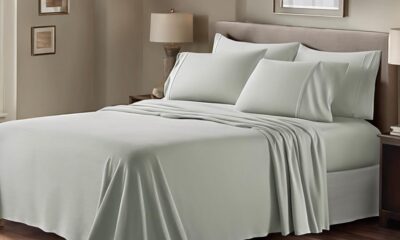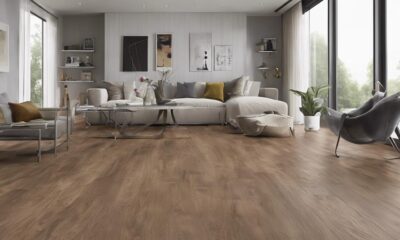Appliances
How Are Ceiling Fans Made
2025
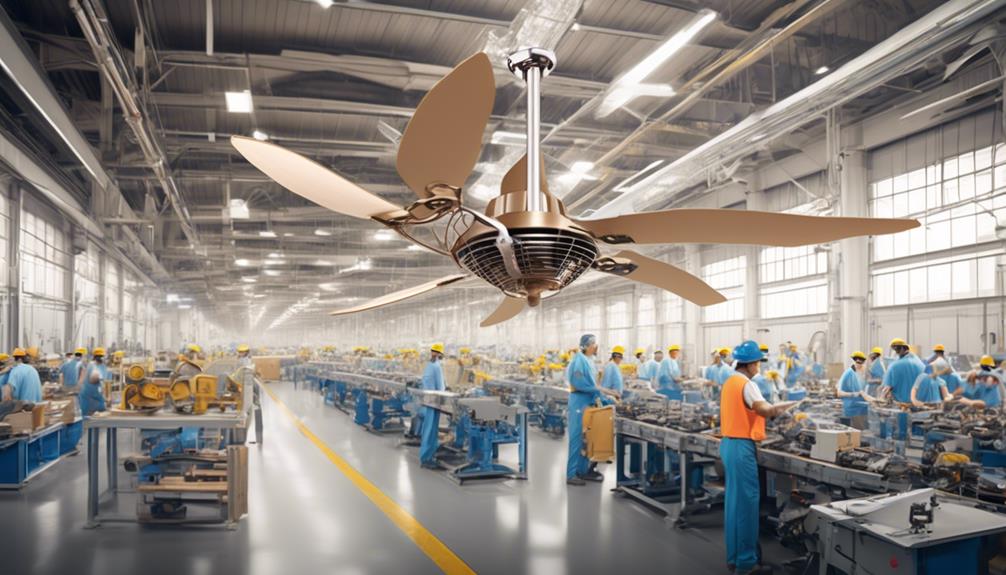
Exploring the captivating realm of ceiling fan production, we uncover the detailed operations that bring to life these essential home devices.
From the selection of materials to the final inspection, every step is meticulously executed to ensure the creation of a high-quality product.
Through careful design and engineering, our team brings together form and function to create a fan that not only circulates air efficiently but also enhances the aesthetics of any space.
With the help of advanced machinery and skilled technicians, the motor and blades are meticulously crafted, ensuring optimal performance and durability.
Assembling the various components, wiring, and electrical installation are done with precision, followed by rigorous quality control and testing procedures.
Finally, the finished product is packaged and distributed to homes around the world, ready to provide comfort and relief on hot summer days.
Key Takeaways
- Ceiling fan blades are commonly made from wood, aluminum, or composite materials.
- The design and engineering process involves considering factors like size, blade shape, and motor specifications, and utilizing advanced CAD software and prototyping for validation.
- The manufacturing process includes winding coils, assembling motor components, molding and shaping blades, and utilizing state-of-the-art machinery to create efficient and reliable motors that meet industry standards.
- Assembling and quality control procedures are followed to ensure proper functionality, durability, and safety, and the finished product is packaged for protection during transportation and distributed worldwide.
Materials Used in Ceiling Fan Manufacturing
What materials are commonly used in the manufacturing of ceiling fans?
Ceiling fan material selection plays a crucial role in ensuring the performance, durability, and overall quality of the product. In order to meet the demands of a discerning audience that desires mastery, manufacturers employ sustainable manufacturing practices for ceiling fans.
The primary material used in the construction of ceiling fan blades is typically wood, aluminum, or composite materials. Wood blades are popular for their natural aesthetics and ability to complement various interior designs. Aluminum blades, on the other hand, offer durability and are often used in commercial settings where robustness is essential. Composite blades, made from a combination of materials such as plastic and fiberglass, provide a balance between aesthetic appeal and durability.
The motor housing, another critical component of a ceiling fan, is commonly made from materials like die-cast aluminum or steel. These materials ensure the motor is adequately protected while providing stability and longevity to the fan.
To further enhance energy efficiency and sustainability, manufacturers are increasingly incorporating recycled materials into the production process. This approach not only reduces waste but also lowers the environmental impact of manufacturing ceiling fans.
Design and Engineering Process

When it comes to the design and engineering process of making ceiling fans, we begin by conceptualizing the fan design. This involves considering factors such as size, blade shape, and motor specifications to ensure optimal performance and efficiency.
Once the design is finalized, we move on to testing and prototyping to validate its functionality and make any necessary adjustments.
This meticulous process ensures that our ceiling fans meet the highest standards of quality and performance.
Conceptualizing the Fan Design
During the design and engineering process of conceptualizing ceiling fans, our team carefully analyzes and evaluates various factors to create an efficient and innovative product.
Design inspiration plays a critical role in this process. We draw inspiration from a variety of sources, including nature, architecture, and industrial design. By studying these sources, we can identify key design principles that can be applied to ceiling fan design. These principles include considerations such as aerodynamics, energy efficiency, and aesthetics.
Our team utilizes advanced computer-aided design (CAD) software to create 3D models that allow us to visualize and refine the fan's design. We also conduct rigorous testing and simulations to ensure that the fan performs optimally in terms of airflow, noise levels, and energy consumption.
Testing and Prototyping
After carefully conceptualizing the design of our ceiling fans and utilizing advanced computer-aided design software, our team proceeds to the crucial stage of testing and prototyping in the design and engineering process. This phase allows us to evaluate the performance optimization and cost analysis of our fan designs before moving into production.
During testing and prototyping, we create a series of prototypes that closely resemble the final product. These prototypes undergo rigorous testing to ensure they meet our performance standards. We evaluate factors such as airflow, noise levels, energy efficiency, and durability. Any necessary adjustments are made to improve the fan's performance and address any issues that arise.
To give you an idea of our testing process, here is a table showcasing the performance metrics we evaluate during the prototyping stage:
| Performance Metric | Description | Testing Method |
|---|---|---|
| Airflow | Measure of the fan's flow | Airflow meter |
| Noise Levels | Assessment of fan noise | Sound level meter |
| Energy Efficiency | Efficiency of power usage | Power consumption meter |
| Durability | Assessment of fan's lifespan | Drop test, vibration test, endurance testing |
Through rigorous testing and prototyping, we ensure that our ceiling fans meet the highest standards of performance optimization and cost-effectiveness.
Manufacturing of Motor and Blades
Now let's turn our attention to the manufacturing process of the motor and blades for ceiling fans.
The motor manufacturing process involves various steps, including winding the coils, assembling the stator and rotor, and testing for performance and efficiency.
On the other hand, blade production techniques encompass molding, shaping, and balancing to ensure optimal airflow and minimal noise.
Motor Manufacturing Process
The manufacturing process of the motor and blades for ceiling fans involves a series of technical and precise steps. When it comes to motor design, our team focuses on creating efficient and reliable motors that meet the highest standards in the industry.
To achieve optimal motor efficiency, we carefully select high-quality materials and employ advanced manufacturing techniques. The first step in the process is the assembly of the motor's stator and rotor, which requires meticulous attention to detail to ensure proper alignment and balance.
We then proceed to the winding process, where copper wire is carefully wound around the stator and rotor cores. This step is crucial for achieving optimal performance and minimizing energy consumption.
Blade Production Techniques
Blade production techniques in the manufacturing of motor and blades involve a meticulous and precise process to ensure optimal performance and efficiency. To create high-quality fan blades, manufacturers employ various manufacturing techniques and carefully select appropriate blade materials.
Injection Molding: This technique involves injecting molten plastic into a mold, allowing for the production of blades with intricate designs and consistent dimensions.
Die Casting: Aluminum or other metal alloys are melted and injected into molds to create durable and lightweight fan blades.
CNC Machining: Computer Numerical Control (CNC) machines are used to precisely cut and shape fan blades from solid blocks of metal or wood.
For blade materials, manufacturers commonly use a range of options such as wood, plastic, or metal alloys. Each material has its advantages, with wood providing a natural and aesthetically pleasing look, plastic offering durability and versatility, and metal alloys ensuring strength and stability.
Assembly of Motor and Blades
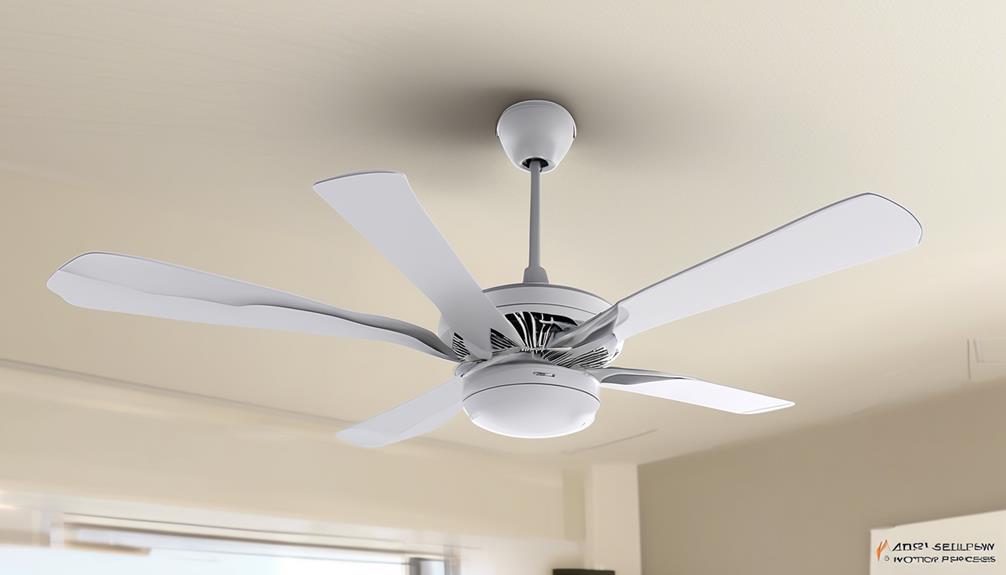
During the assembly process, we carefully attach the motor to the blades, ensuring a secure and efficient connection. The motor assembly is a critical step in the production of ceiling fans, as it determines the overall performance and functionality of the fan.
To begin, we align the motor housing with the pre-drilled holes on the blades. Using specialized screws and bolts, we fasten the motor securely to the blades, ensuring that it's properly aligned and balanced.
Next, we install the blade brackets onto the motor housing. These brackets serve as the connection point for the blades. We make sure to align the brackets precisely, ensuring that the blades will be balanced and rotate smoothly. Once the brackets are in place, we attach the blades onto them, using screws or other fastening mechanisms.
Throughout the assembly process, we double-check all connections and alignments to ensure that the motor and blades are securely and correctly attached. This attention to detail is crucial for the efficient and quiet operation of the ceiling fan.
Wiring and Electrical Components Installation

To ensure the safe and efficient operation of the ceiling fan, we carefully install the wiring and electrical components. This step is crucial to ensure electrical safety and prevent any potential hazards. The installation process involves the following:
- Wiring: We connect the electrical wires from the motor to the appropriate terminals on the fan's control switch. This step requires precision to ensure proper functioning and prevent any short circuits or electrical malfunctions.
- Capacitors: Capacitors are essential components that help regulate the fan's speed. We install them according to the manufacturer's specifications, ensuring they're securely connected and properly insulated.
- Switches and Controls: We install the fan's switches and controls, including the pull chain switch and any additional controls such as remote control receivers. These components are carefully mounted and wired to the fan to provide seamless operation and convenience.
Throughout the installation process, we adhere to strict electrical safety guidelines. We ensure that all connections are secure, wires are properly insulated, and components are correctly installed. Additionally, we conduct thorough testing to verify proper functionality and to guarantee the fan's safe and reliable operation.
Quality Control and Testing Procedures

In our quality control and testing procedures, we meticulously evaluate the performance and functionality of the ceiling fan to ensure its adherence to safety standards and optimal operation. Our goal is to deliver a high-quality product that meets the expectations of our customers.
To achieve this, we've established a series of rigorous tests and inspections throughout the manufacturing process.
Firstly, we conduct thorough inspections of the fan's components, including the motor, blades, and housing, to ensure that they're free from defects and meet our strict manufacturing standards. We pay close attention to details such as the alignment of the blades and the balance of the fan to ensure smooth and efficient operation.
Next, we subject the fan to a battery of performance tests to evaluate its airflow, noise levels, and energy efficiency. These tests are conducted in controlled environments to accurately measure the fan's performance under different conditions. We use advanced instruments and equipment to gather precise data, allowing us to verify that the fan meets our performance standards.
Furthermore, we conduct safety tests to ensure that the fan is designed and manufactured with the utmost care. These tests evaluate the fan's electrical safety, stability, and resistance to extreme conditions. We also test the fan's durability by simulating years of use and subjecting it to various environmental factors.
Packaging and Distribution Process
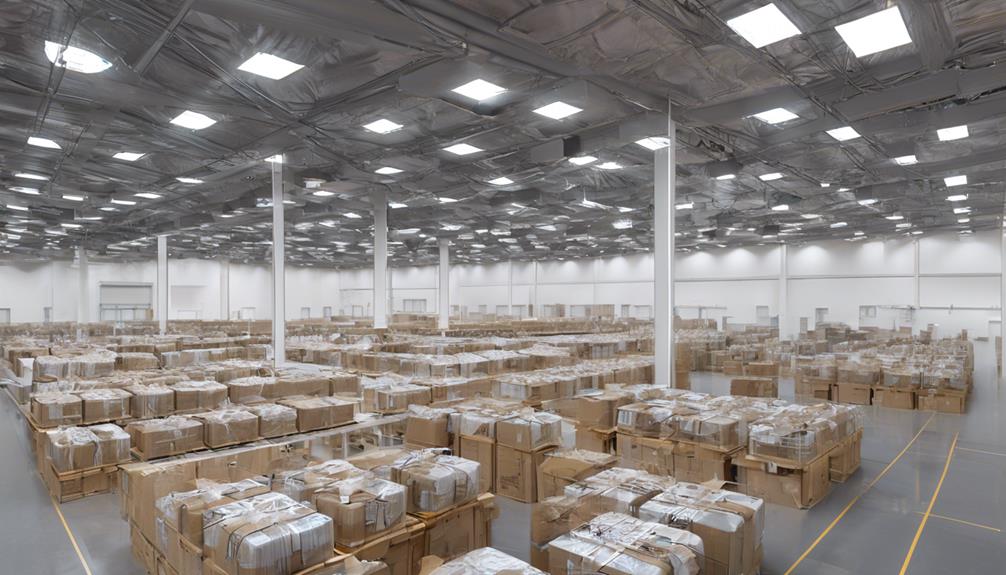
Having ensured the quality and performance of our ceiling fans through rigorous testing and inspections, we now turn our attention to the packaging and distribution process. This stage is crucial in ensuring that our products reach customers in optimal condition and within the shortest possible time.
To achieve this, we employ packaging efficiency techniques and carefully plan our distribution logistics.
- Packaging Efficiency:
- We use lightweight and durable materials that provide adequate protection for the ceiling fans during transportation.
- Our packaging design is optimized to maximize space utilization, reducing the overall volume and weight of each package.
- We implement strict quality control measures to ensure that our packaging materials meet industry standards and can withstand various handling conditions.
- Distribution Logistics:
- We work closely with logistics partners to optimize the transportation routes, minimizing transit times and costs.
- Our distribution centers are strategically located to enable efficient order fulfillment and ensure timely delivery to customers.
- We employ advanced inventory management systems to track and monitor the movement of products, enabling us to respond swiftly to customer demands.
What Materials and Processes Are Used in Making Different Brands of Ceiling Fans?
When identifying ceiling fan brands, it’s important to understand the materials and processes used in their manufacturing. Different brands may use a variety of materials such as wood, metal, or plastic for fan blades and housings, while processes like injection molding and die casting are commonly used for production.
Frequently Asked Questions
How Do Ceiling Fans Work?
Ceiling fans work by utilizing a set of rotating blades attached to a central motor. The blades are designed to move air in a downward direction, creating a cooling effect in the room.
The speed of the blades can be controlled through various mechanisms, such as pull chains or remote controls, allowing for customized airflow.
Are Ceiling Fans Energy-Efficient?
Ceiling fans, like a gentle breeze on a warm summer day, are an energy-efficient solution to cooling our homes. When considering ceiling fan designs, it's important to note the various benefits they offer.
These fans can help circulate cool air in the summer and distribute warm air during the winter, reducing the need for excessive air conditioning or heating. By using less energy than traditional cooling methods, ceiling fans contribute to energy savings and a more sustainable environment.
Can Ceiling Fans Be Used Outdoors?
Outdoor ceiling fan options provide numerous benefits for using ceiling fans outdoors. They're specifically designed to withstand various weather conditions and are made with durable materials.
Using ceiling fans outdoors can help to create a comfortable and cool environment during hot summer months. Additionally, they can help to circulate fresh air, reducing the need for air conditioning and ultimately saving energy.
What Is the Average Lifespan of a Ceiling Fan?
The average lifespan of a ceiling fan depends on several factors such as usage, maintenance, and quality. With proper care and regular maintenance, a well-made ceiling fan can last for around 10-15 years.
To ensure longevity, it's essential to clean the fan blades regularly, check for any loose screws or parts, and lubricate the motor as needed. Following these maintenance tips can help maximize the lifespan of your ceiling fan and keep it running smoothly for years to come.
Are There Any Safety Precautions to Consider When Installing a Ceiling Fan?
When installing a ceiling fan, there are important safety precautions to consider. Proper installation requires knowledge of electrical wiring and adherence to building codes.
We recommend turning off the power at the circuit breaker before starting the installation process. Additionally, it's crucial to follow the manufacturer's instructions carefully and use the appropriate tools.
Inspecting the electrical connections and ensuring they're secure is essential for safe operation. Lastly, always consult a professional if you're unsure about any aspect of ceiling fan installation.
Conclusion
After a meticulous process of design, engineering, and manufacturing, ceiling fans come to life as functional and aesthetically pleasing appliances.
The careful selection of materials, precise assembly of motor and blades, and installation of wiring and electrical components ensure their performance and longevity.
Quality control and testing procedures guarantee that each fan meets the highest standards.
Finally, packaging and distribution bring these cooling companions to homes worldwide, where they circulate gentle breezes and provide relief from the summer heat.
- About the Author
- Latest Posts
Introducing Ron, the home decor aficionado at ByRetreat, whose passion for creating beautiful and inviting spaces is at the heart of his work. With his deep knowledge of home decor and his innate sense of style, Ron brings a wealth of expertise and a keen eye for detail to the ByRetreat team.
Ron’s love for home decor goes beyond aesthetics; he understands that our surroundings play a significant role in our overall well-being and productivity. With this in mind, Ron is dedicated to transforming remote workspaces into havens of comfort, functionality, and beauty.
Garage Door Opener
Clearance Garage Door Opener Installation Guide
Navigate the complexities of installing a garage door opener with ample overhead clearance, uncovering the key steps for a seamless setup.
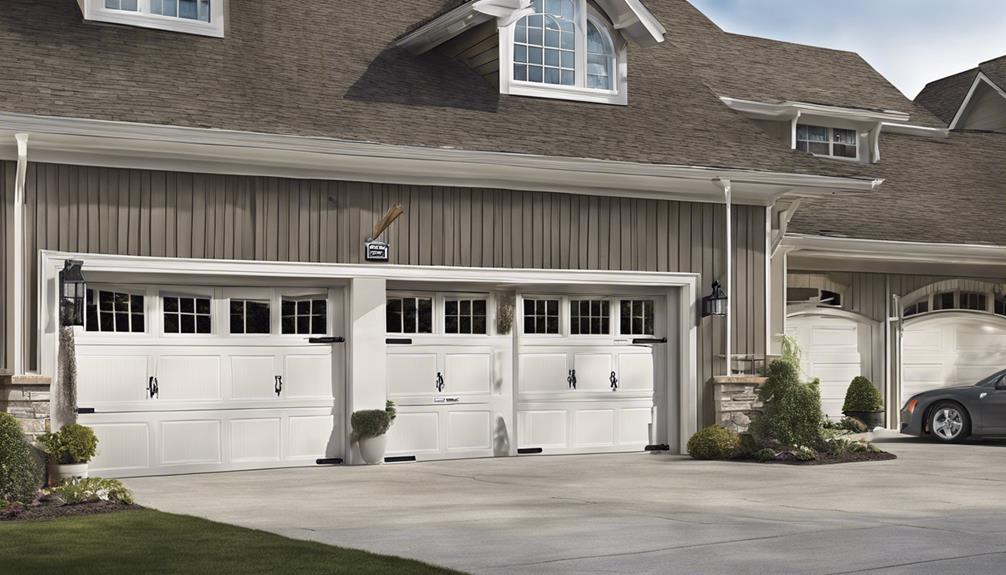
Have you ever thought about the details involved in installing a garage door opener with enough overhead clearance? How difficult is it to make sure the installation is smooth and guarantees the best performance? Well, don’t worry, as we will walk you through the necessary steps for getting your garage door opener set up.
From measuring overhead space to selecting the right opener and testing its functionality, our discussion will equip you with the necessary knowledge to tackle this task effectively. Let's unravel the secrets to a successful garage door opener installation together.
Key Takeaways
- Accurate measurement and ample clearance space are crucial for smooth installation.
- Choose a low-profile opener for limited headroom, featuring modern connectivity and quiet operation.
- Prepare a clutter-free workspace with proper lighting for efficient installation.
- Test functionality thoroughly, adjusting as needed for safe and optimal garage door operation.
Measure Overhead Clearance Space
To ensure proper installation of the garage door opener, it's crucial to accurately measure the overhead clearance space between the top of the garage door and the ceiling. The vertical space is essential for the garage door opener and its components to operate smoothly and without any hindrances.
When measuring the overhead clearance, take into account the drive garage door opener's specifications provided by the manufacturer. These specifications will outline the required vertical space needed for the specific model being installed. Additionally, consider any extra accessories or modifications that may impact the overhead clearance space, ensuring that there's ample room for safe and efficient operation.
Select Low-Profile Garage Door Opener

Having ensured the adequate overhead clearance space for the garage door opener installation, the next step is to carefully select a low-profile garage door opener that fits snugly in tight spaces while offering advanced features and compatibility with various door types.
Low-profile garage door openers are specifically designed to accommodate limited headroom situations, making them perfect for garages with space constraints. Their compact and sleek design allows for discreet installation without occupying much room. These openers often come equipped with modern conveniences like smartphone connectivity, battery backup, and quiet belt drive operation for a seamless user experience. Additionally, their compatibility with a range of garage door sizes and types provides installation flexibility.
Energy efficiency is another advantage, as low-profile garage door openers can help reduce electricity consumption, leading to potential long-term cost savings. When choosing a low-profile garage door opener, consider factors such as the size of your garage door and the desired features for optimal performance.
Prepare Workspace for Installation
Clearing the area around the garage door opener is essential to provide ample space for a smooth installation process. Before beginning the installation of the garage door opener, it's crucial to ensure that there are no obstructions or clutter that may hinder the process.
By creating a clean and organized workspace, you can work efficiently and safely. Remove any tools or items that may interfere with the installation of the garage door opener to streamline the process. Keeping the workspace well-lit and free from distractions will allow you to focus on the installation tasks at hand.
Install Opener According to Manual
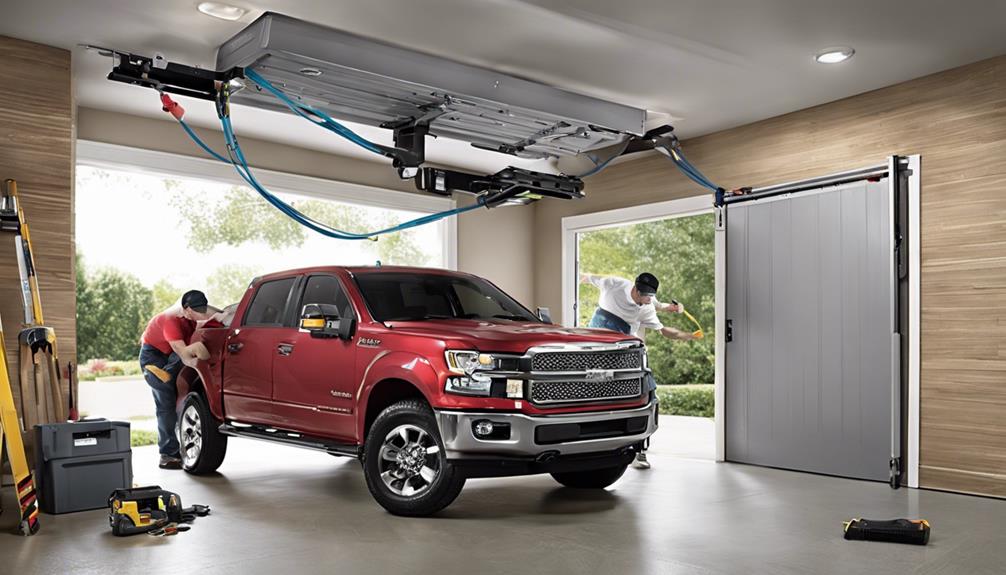
Following the manufacturer's manual meticulously is crucial for the precise installation of the garage door opener. To ensure a successful installation, our team recommends the following steps:
- Positioning Components: Properly position and secure all garage door opener components as instructed in the manual. This ensures the safe and efficient operation of the opener.
- Connecting Wiring: Connect all wiring and mechanisms according to the manual's specifications. Proper connection is vital to prevent malfunctions and ensure smooth functioning of the garage door.
- Adhering to Guidelines: Adhere strictly to the manual's guidelines for installing the opener. These guidelines are designed by professional garage door experts to guarantee a correct and secure installation.
Test Functionality and Adjust if Needed
To ensure the garage door opener functions smoothly and safely, thorough testing and potential adjustments are essential. Begin by testing the garage door's opening and closing functionality multiple times to guarantee a seamless operation.
Listen for any unusual sounds and watch out for jerky movements or obstructions that may impede the door's movement. If any issues arise, consider adjusting the opener's settings to enhance the door's operation and clearance within the garage space.
It's crucial to verify that the door clears the opening without any problems or interference. Additionally, confirm that the safety sensors are operational and don't hinder the door's movement in any way, ensuring a safe and efficient garage door operation.
Frequently Asked Questions
How Much Clearance Do You Need to Install a Garage Door Opener?
We need a minimum of 2 inches of clearance above the garage door for installing most openers. It's crucial to check the manufacturer's specifications for the exact clearance required by your specific opener model.
Taller doors or special opener features may demand more clearance. The needed space can vary depending on the opener type, like chain-drive, belt-drive, or screw-drive.
Adequate clearance ensures smooth opener operation and prevents door movement interference.
What Is the Minimum Clearance Above a Garage Door for an Opener?
We need at least 2 inches of clearance above a garage door for an opener to work effectively. Some models might require up to 3 inches, depending on their design. Too little space can lead to operational issues and potential damage.
It's crucial to measure accurately before installing to avoid problems. Always refer to the manufacturer's guidelines for the specific opener model to ensure the right clearance.
How Much Does Lowes Charge to Install a Garage Door Opener?
We love the convenience of Lowe's garage door opener installation services, starting at $127, with pricing varying based on installation complexity.
Extra charges may apply for services like removing old openers or installing new electrical outlets. Remember, the installation cost doesn't include the price of the garage door opener itself, which must be purchased separately.
Rest assured, Lowe's provides professional installation by licensed and insured contractors for peace of mind.
How Close Do You Have to Be for Garage Door Opener?
We need to be within 25-35 feet for the garage door opener to work.
Sensors should be placed 4-6 inches above the floor to detect obstacles.
Some models offer Wi-Fi connectivity, enabling remote access.
Advanced features like battery backup ensure operation during power outages.
These key factors influence how close we must be for the garage door opener to function effectively.
Conclusion
In conclusion, installing a low-profile garage door opener is like fitting a key into a lock – precise, smooth, and essential for seamless operation.
By following the detailed steps in the clearance garage door opener installation guide, you can ensure your opener functions flawlessly and efficiently.
Remember to test the functionality and make any necessary adjustments for optimal performance.
With proper installation and maintenance, your garage door opener will open up a world of convenience for you.
- About the Author
- Latest Posts
Introducing Ron, the home decor aficionado at ByRetreat, whose passion for creating beautiful and inviting spaces is at the heart of his work. With his deep knowledge of home decor and his innate sense of style, Ron brings a wealth of expertise and a keen eye for detail to the ByRetreat team.
Ron’s love for home decor goes beyond aesthetics; he understands that our surroundings play a significant role in our overall well-being and productivity. With this in mind, Ron is dedicated to transforming remote workspaces into havens of comfort, functionality, and beauty.
Garage Door Opener
What Makes the Glink Garage Door Opener Stand Out?
Outstanding safety features and user-friendly functionalities distinguish the Glink Garage Door Opener – but what else makes it a game-changer?
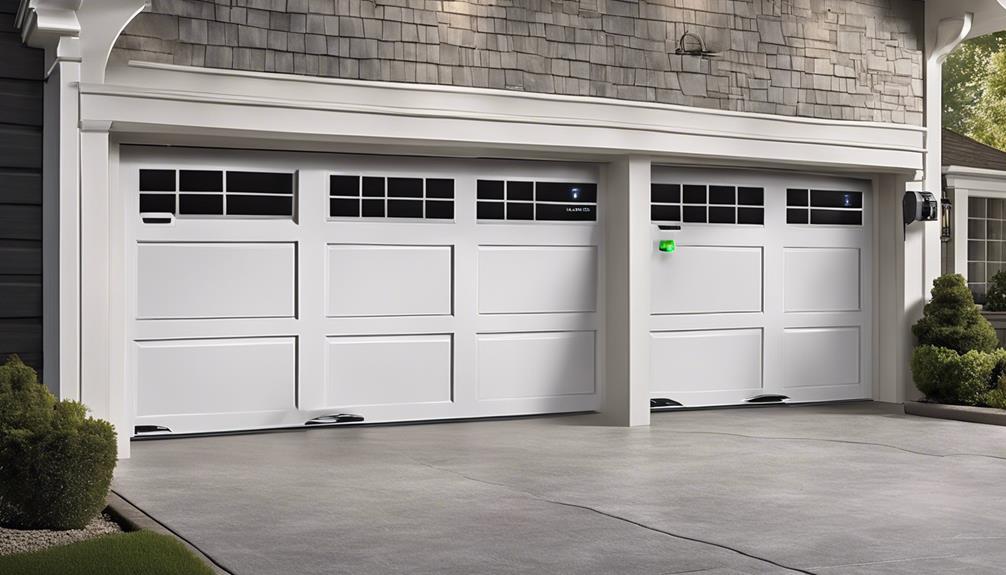
When it comes to garage door openers, the Glink Garage Door Opener really stands out. Its unparalleled level of innovation and attention to detail in features sets it apart in the market.
From cutting-edge safety measures to user-friendly functionalities, the Glink Garage Door Opener has redefined what we expect from this essential home device.
But what exactly makes it stand out from the rest? Let's explore further.
Key Takeaways
- Built-in camera for live monitoring adds security and convenience.
- Belt-driven openers ensure quiet performance for a peaceful environment.
- Advanced Wi-Fi connectivity allows for remote access and smart home integration.
- High-grade steel construction and advanced motor technology ensure durability and reliability.
Innovative Features of Glink Garage Door Opener
The Glink Garage Door Opener revolutionizes home security with its cutting-edge built-in camera for live monitoring capabilities, setting a new standard in garage door technology. When it comes to garage door maintenance, one crucial aspect is the proper lubrication of moving parts to ensure smooth operation. The Glink opener excels in this area by incorporating a sophisticated spring system that enhances the overall functionality and longevity of the garage door.
Furthermore, the Glink Garage Door Opener is designed with belt-driven openers that not only reduce the noise during operation but also provide a more reliable performance compared to chain-driven systems. This innovative feature enhances the user experience by offering a quieter and more efficient operation that's essential for modern homeowners seeking convenience and peace of mind.
User-Friendly Design Highlights
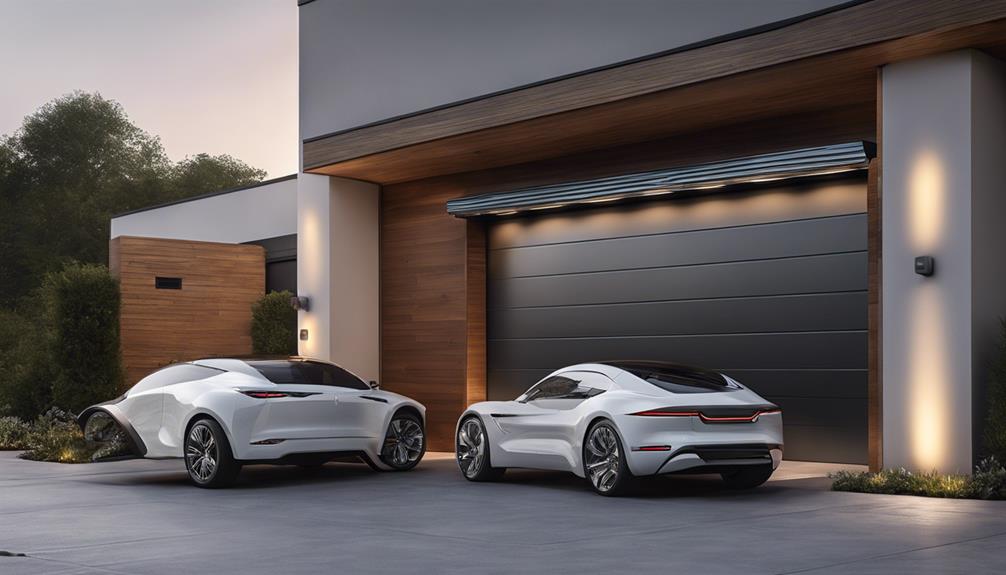
Featuring intuitive controls and seamless integration with smart home systems, the user-friendly design of the Glink Garage Door Opener offers unparalleled convenience and security for homeowners. Here are some highlights that make it stand out:
- Easy-to-Use Controls: The Glink Garage Door Opener provides straightforward controls, allowing users to operate their garage doors with ease.
- Smart Home Integration: With compatibility for smart home systems, users can conveniently monitor and control their garage doors remotely using their smartphones or voice commands.
- Safety Sensors: Equipped with advanced safety sensors, the opener detects obstacles in the door's path, ensuring the safety of both people and property.
- Quiet Operation: The Glink Garage Door Opener operates quietly, making it ideal for garages attached to living spaces where noise reduction is essential.
The straightforward installation and setup process further enhance the user-friendly experience, making the Glink Garage Door Opener a hassle-free addition to any home.
Reliable Performance Factors
Among the standout features of the Glink Garage Door Opener, its reliable performance factors set a high standard in the realm of garage door operation and security.
The Glink Garage Door Opener utilizes DC motors, which provide efficient and smooth operation, especially when paired with a belt-driven garage door mechanism. This combination not only ensures a reliable performance but also contributes to reducing the noise level during door operation, making it ideal for homes where noise pollution is a concern.
Additionally, the inclusion of a safety sensor system enhances the overall reliability of the opener by detecting any obstructions and prompting the door to stop and reverse its motion, prioritizing user safety.
Moreover, the smart technology integration allows for convenient control and monitoring of the garage door opener remotely, adding an extra layer of security and accessibility.
The Glink Garage Door Opener's reliable performance factors make it a top choice for those seeking a dependable and efficient garage door solution.
Glink Garage Door Opener Durability
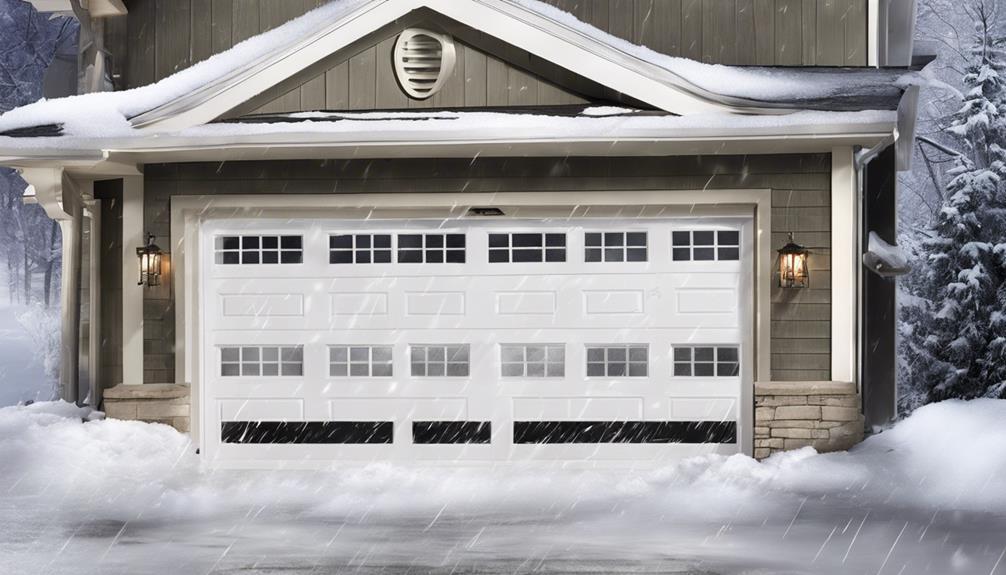
How does the durability of the Glink Garage Door Opener compare to other models on the market? When it comes to lasting strength and reliability, the Glink Garage Door Opener stands out from the competition. Here's why:
- Durable Materials: Crafted from high-grade steel and reinforced components, the Glink Garage Door Opener is built to withstand the test of time, ensuring longevity and robust performance.
- Advanced Motor Technology: Equipped with cutting-edge motor technology, this opener delivers powerful and efficient operation, enhancing its durability and overall functionality.
- Residential Garage Door Operation: Designed specifically for residential use, the Glink Garage Door Opener is tailored to meet the demands of daily home access, supporting consistent and reliable performance.
- Minimal Maintenance Requirements: With a focus on user convenience, this opener requires minimal maintenance, allowing homeowners to enjoy hassle-free operation without frequent upkeep tasks.
Standout Technology in Glink Opener
The advanced Wi-Fi connectivity of the Glink Garage Door Opener sets it apart in the realm of smart home technology, offering users convenient remote access to their garage door from any location. This feature enables seamless control through the Glink mobile app, empowering users to monitor and manage their garage door with just a few taps on their smartphone. Moreover, the Glink Opener's compatibility with voice assistants such as Amazon Alexa and Google Assistant adds a layer of hands-free convenience, allowing users to operate their garage door effortlessly using voice commands.
The integration of smart technology in the Glink Garage Door Opener further enhances its standout features. Through real-time alerts and notifications, users are kept informed about the status of their garage door, enhancing both security and peace of mind. Additionally, the ability to schedule automatic opening and closing times streamlines daily routines, making the overall user experience more efficient and tailored to individual preferences. The Glink Opener truly represents a modern approach to garage door operation, combining innovation with practicality for a liberating user experience.
Frequently Asked Questions
How Can I Boost My Garage Door Opener Signal?
To boost our garage door opener signal, we can take several steps.
Reposition the antenna for better reception and remove any obstructions blocking the signal.
Upgrading to a dual-frequency remote control can enhance signal strength.
Installing a repeater or range extender can amplify the signal.
Checking for interference from nearby electronics is crucial to ensure a smooth signal transmission.
These steps can help improve the overall performance of our garage door opener system.
Which Is Better a Chain or Belt Garage Door Opener?
When comparing a chain and belt garage door opener, it's crucial to consider factors like noise level, cost, reliability, and durability based on personal needs.
Chain openers are cost-effective and robust, ideal for heavy doors or high-traffic areas.
On the other hand, belt openers offer quieter operation and require less maintenance.
Ultimately, the choice depends on individual preferences, budget constraints, and specific garage door requirements.
What Is the Best Residential Garage Door Opener?
When it comes to choosing the best residential garage door opener, safety features like automatic reversing and rolling code technology are crucial. Battery backups ensure operation during power outages, while security lights provide added safety. Consider different types such as chain-driven, belt-driven, screw-driven, direct drive, and jackshaft models.
LiftMaster series like 8365, Elite Series 8550 DC, and 8500 offer excellent features for residential use, catering to various needs.
How Much Horsepower Do I Need for a 2 Car Garage Door?
We've got the know-how on garage door openers! A 1/2 horsepower opener is typically enough for a standard 2 car garage door.
If you've got a heavier or insulated door, consider bumping up to a 3/4 or 1 horsepower for optimal performance. The right horsepower ensures smooth operation and longevity for your opener.
Consult a pro to determine the best fit for your specific garage door setup.
Conclusion
In conclusion, the Glink Garage Door Opener truly shines with its innovative features, user-friendly design, reliable performance, and durability.
It stands out in the market for its advanced safety technology and standout features like automatic reversing and rolling code encryption.
With the Glink Garage Door Opener, you can rest assured that your garage door will operate smoothly and securely.
It's like having a guardian angel watching over your home's entrance.
- About the Author
- Latest Posts
Introducing Ron, the home decor aficionado at ByRetreat, whose passion for creating beautiful and inviting spaces is at the heart of his work. With his deep knowledge of home decor and his innate sense of style, Ron brings a wealth of expertise and a keen eye for detail to the ByRetreat team.
Ron’s love for home decor goes beyond aesthetics; he understands that our surroundings play a significant role in our overall well-being and productivity. With this in mind, Ron is dedicated to transforming remote workspaces into havens of comfort, functionality, and beauty.
Garage Door Opener
Silencing Your Garage Door Opener Humming: A Step-by-Step Guide
Discover how to silence your garage door opener humming with expert tips and tricks, transforming your space into a noise-free haven.

We’ve got you covered with practical steps to tackle the noise when it comes to silencing your garage door opener humming.
From pinpointing the source of the hum to exploring maintenance techniques, our guide offers a comprehensive approach to quieting your garage door opener.
By implementing these methods, you can create a peaceful environment without the constant background hum.
So, are you ready to transform your garage into a serene space?
Key Takeaways
- Inspect transformer for issues in Legacy 850/Standard Drive 650 models.
- Tighten all hardware components to minimize vibrations and humming.
- Regularly lubricate moving parts to reduce friction and noise.
- Adjust opener settings for optimized force and smooth operation.
Identifying the Source of Humming
To pinpoint the source of the humming noise in your garage door opener, start by examining the transformer located in the motor head for any signs of malfunction. The transformer is crucial for converting incoming power to the appropriate voltage needed to operate the DC motors in garage door openers like the Legacy 850 or Standard Drive 650.
If you own one of these models and notice a persistent humming sound, the transformer may be the culprit. For Legacy 850 or Standard Drive 650 units with a date code before 15198, replacing the transformer (part #39342RS) is often the solution. These replacement transformers for Overhead Door model openers can be easily sourced from www.OverheadDoorPartsOnline.com.
If you encounter any challenges during the replacement process or need further assistance, don't hesitate to reach out to your local Overhead Door distributor at 1-800-929-3667 for expert technical support. Identifying and addressing issues with the transformer can help silence the humming and ensure smooth operation of your garage door opener.
Inspecting and Tightening Hardware

Inspecting and tightening the hardware components of your garage door opener is crucial to identifying and addressing potential sources of humming noise. Begin by checking for loose nuts, bolts, and screws on the opener. Using a wrench, tighten all hardware components securely to reduce vibrations and minimize humming. Ensure that the mounting brackets, chains, and railings are properly fastened to prevent unnecessary movement and humming. It's also essential to inspect the motor head and drive system for any loose parts that could be causing the humming sound.
Regularly tightening and securing the hardware of your garage door opener is key to maintaining a quiet and efficient operation. Loose components can lead to increased vibrations and noise levels. By keeping all nuts, bolts, screws, mounting brackets, chains, railings, and motor head properly tightened, you can significantly reduce the humming noise coming from your garage door opener. This simple maintenance task can make a big difference in the overall performance of your garage door system.
Lubricating Moving Parts
When lubricating the moving parts of your garage door opener to reduce humming noise, ensure thorough coverage using a garage door lubricant or silicone-based option. Regular maintenance of your garage door opener includes proper lubrication of its moving parts such as the chain, belt, or screw drive. This lubrication helps reduce noise by preventing excess friction between the components. To assist you in understanding which lubricant to use and where to apply it, refer to the table below:
| Moving Parts | Recommended Lubricant |
|---|---|
| Chain Drive | Garage Door Lubricant |
| Belt Drive | Silicone-Based Lubricant |
| Screw Drive | Garage Door Lubricant |
Adjusting Garage Door Opener Settings

Adjust garage door opener settings to minimize humming noise by accessing the control panel and fine-tuning force and travel limits. Here's how to do it:
- Access the Control Panel:
- Locate the control panel on your garage door opener, usually found near the motor unit.
- Open the panel cover to reveal the adjustment settings.
- Adjust Force Settings:
- Use a flathead screwdriver to adjust the force settings on the opener.
- Increase or decrease the force to find the optimal setting that reduces resistance and noise.
- Fine-Tune Travel Limits:
- Locate the travel limit adjustment screws on the control panel.
- Gradually adjust the travel limits for both opening and closing directions.
- Test the door after each adjustment to ensure it opens and closes smoothly without excessive noise.
Seeking Professional Help
For addressing unusual humming sounds in your garage door opener, it is advisable to seek professional assistance from a certified technician. When dealing with a persistent humming noise coming from your garage door opener, it is crucial to involve experts who can accurately diagnose and resolve the issue. Certified technicians have the knowledge and experience to identify the source of the unusual sound and provide appropriate solutions to eliminate it effectively.
To guide you in understanding the benefits of seeking professional help, refer to the table below:
| Benefits of Seeking Professional Help | |
|---|---|
| 1. Expert Diagnosis | Certified technicians can pinpoint the exact cause of the humming noise. |
| 2. Precise Resolution | Professionals offer targeted solutions to resolve the issue efficiently. |
| 3. Technical Support | Get access to specialized assistance for your garage door opener complications. |
| 4. Prevent Further Damage | Avoid potential harm by allowing trained professionals to handle the motor head. |
When faced with a garage door opener humming problem, don't hesitate to reach out to a certified technician for technical support and expert troubleshooting.
Frequently Asked Questions
How Do I Silence My Garage Door Opener?
To silence your garage door opener, locate the source of the noise, which may be the motor head. Check the transformer for any issues causing the humming sound.
If you have a Legacy 850 or similar model, consider replacing the transformer part. For specific parts and guidance, visit OverheadDoorPartsOnline.com or reach out to a local distributor for assistance.
This process will help eliminate the unwanted noise from your garage door opener.
Why Is My Garage Door Opener Making a Humming Noise?
We discovered why our garage door opener is humming. It seems the culprit might be a faulty transformer in the motor head.
This issue is common in garage door openers with DC motors like the Overhead Door Phantom (777CD) and Legacy 850 (2029). If you have a Legacy 850 with a date code before 15198, replacing the transformer (part #39342RS) could be the fix.
Look for replacement transformers at www.OverheadDoorPartsOnline.com or call 1-800-929-3667 for help.
How Do I Make My Garage Door Not Loud?
To make our garage door not loud, we can start by lubricating the moving parts to reduce noise from friction. Check for loose chains or belts that might be causing the loudness.
Upgrading to a belt-driven opener can also help for quieter operation. Inspect the motor head for loose components.
If the noise persists, it's best to seek help from a professional technician for an effective solution.
How Do I Stop My Electric Buzzing?
If you're looking to halt that electric buzzing, we've got you covered.
First, pinpoint the source of the sound, often linked to a malfunctioning transformer in the motor head. Models like the Overhead Door Phantom (777CD) and Legacy 850 (2029) with DC motors commonly face this issue.
For specific models like the Legacy 850 or Standard Drive 650 predating 15198, think about replacing the transformer (part #39342RS).
Need replacement transformers? Check out www.OverheadDoorPartsOnline.com.
Conclusion
In conclusion, by following the steps outlined in this guide, we can effectively address the issue of garage door opener humming and ensure a more peaceful and efficient operation.
Remember, with regular maintenance and proper care, we can achieve a quieter and smoother functioning garage door opener.
Don't hesitate to seek professional assistance if needed, as it can further enhance the performance of your garage door system.
- About the Author
- Latest Posts
Introducing Ron, the home decor aficionado at ByRetreat, whose passion for creating beautiful and inviting spaces is at the heart of his work. With his deep knowledge of home decor and his innate sense of style, Ron brings a wealth of expertise and a keen eye for detail to the ByRetreat team.
Ron’s love for home decor goes beyond aesthetics; he understands that our surroundings play a significant role in our overall well-being and productivity. With this in mind, Ron is dedicated to transforming remote workspaces into havens of comfort, functionality, and beauty.
-
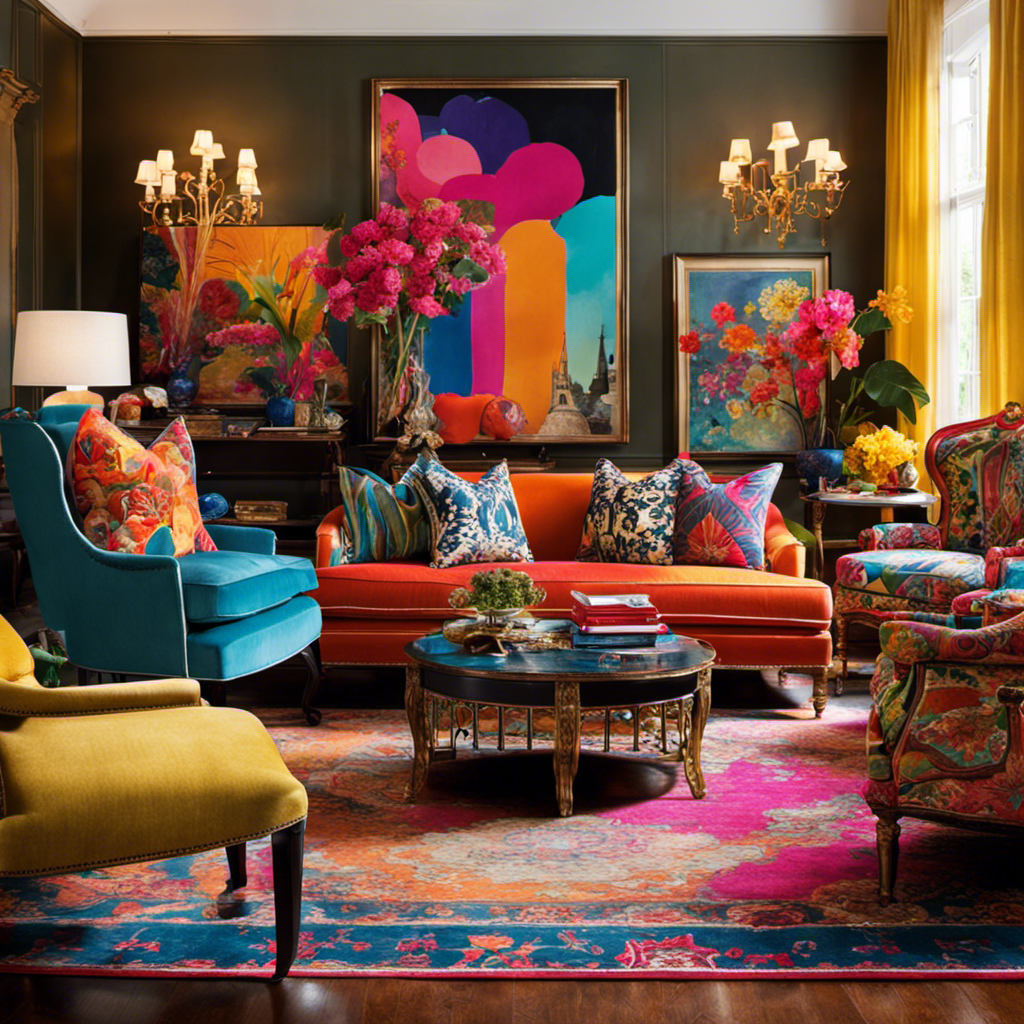
 Decor2 weeks ago
Decor2 weeks agoMaximalist Decor Explained: Embrace More Style
-

 Vetted2 weeks ago
Vetted2 weeks ago15 Best Foot Massagers for Neuropathy to Soothe Your Feet and Relieve Discomfort
-

 Vetted3 weeks ago
Vetted3 weeks ago15 Best Sports Laundry Detergents for Keeping Your Activewear Fresh and Clean
-

 Vetted3 weeks ago
Vetted3 weeks ago15 Best Tall Toilets for Seniors That Combine Comfort and Safety
-

 Vetted4 weeks ago
Vetted4 weeks ago15 Best Dish Scrubbers to Keep Your Kitchen Sparkling Clean
-

 Vetted3 days ago
Vetted3 days ago15 Best Cleaners for Fiberglass Showers to Keep Your Bathroom Sparkling Clean
-

 Decor4 weeks ago
Decor4 weeks agoWhat Is Eclectic Home Decor
-
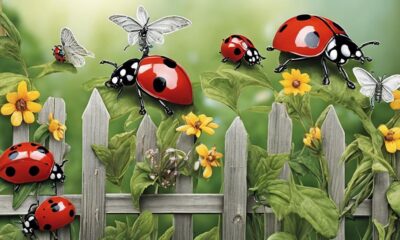
 Vetted1 week ago
Vetted1 week ago15 Best Organic Pest Control Solutions for a Naturally Pest-Free Home










